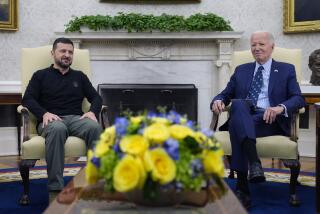Boeing’s Big Army Contract Revised
- Share via
In a boost to its operations in Southern California, Boeing Co. said Monday that it signed a revised military contract that could pump an additional $6.4 billion into its project to develop a new generation of weapons and computer technologies for the U.S. Army.
The funding would be on top of the $14.7-billion contract Boeing won two years ago to lead development of the so-called Future Combat Systems, a collection of high-tech vehicles -- both manned and robotic -- and weapons linked by satellites. Considered the Army’s most significant modernization effort, the new systems would allow soldiers to be more agile and better-informed on the battlefield.
The funding increase reflects the Army’s decision last month to delay deploying the full system by two years to 2014 because of greater-than-anticipated challenges in developing some of the technology.
But the modified contract also includes funds to speed up development of certain technologies that the Pentagon would like to begin using as soon as possible. They include new computer networking software and communication systems, which are being developed by Boeing engineers in Southern California.
“This actually will accelerate work that is going on in Southern California,” said Dennis Muilenburg, Boeing’s general manager for Future Combat Systems.
About 700 engineers work on the program in Huntington Beach. The payroll probably will increase significantly within the next few years, although by exactly how much is not yet clear.
Boeing was tapped in 2002 to be the lead system integrator for the program, which marked the first time that the Army had turned to a single defense contractor to oversee development of a range of new technologies and weapons. It is one of the biggest and most ambitious contracts ever secured by the world’s largest aerospace company.
Chicago-based Boeing is the largest private employer in the region with 36,000 workers.
In recent months, the program has come under increasing scrutiny mainly because of doubts that completely networked combat units could be fielded by 2012.
A recent study indicated that the original timetable for deploying the system had a 28% chance of succeeding, whereas the new schedule would have a 70% chance of success.
One problem has been coming up with a computer network that could link all of the various armored vehicles, helicopters and robotic vehicles. Some of the computer systems would require 34 million lines of code, far more than the 2 million lines of code that control one of the most advanced jet fighters in the U.S. arsenal.
The Army also restructured the program last month. That has raised additional concerns among some analysts because annual funding was reduced for the initial years of development and expanded for later years, making the program more vulnerable to cuts. Congress must approve funding for the program every year.
Boeing shares rose 43 cents to $48.76 in trading on the New York Stock Exchange.
More to Read
Inside the business of entertainment
The Wide Shot brings you news, analysis and insights on everything from streaming wars to production — and what it all means for the future.
You may occasionally receive promotional content from the Los Angeles Times.










